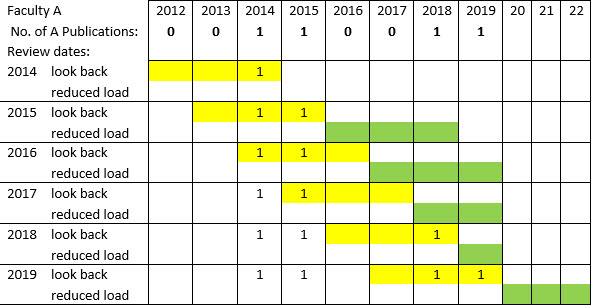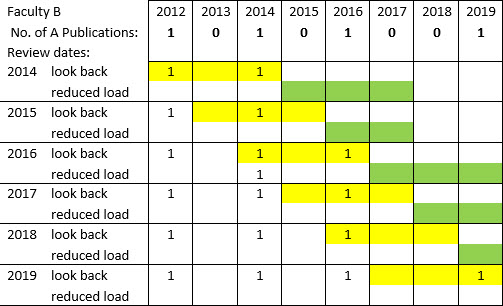School of Business Teaching Load Policy
Each faculty member is responsible for developing a plan, along with their Area Director, on how each faculty member will contribute to the teaching mission of the School, consistent with this policy and the needs of the teaching area and programs. This plan will be updated and reviewed annually by the faculty member and the Area Director. It is recognized that for various reasons an individual’s teaching contributions may not satisfy the teaching load obligations in any given year. Teaching contributions are expected to satisfy obligations on a rolling two-year basis. It is the responsibility of Area Directors, working with the Associate Dean, to ensure that the policy is applied consistently across the faculty.
Teaching loads will vary primarily by the number of students taught and research activity. For number of students, classes with enrollments of approximately 200 students or more count as 2 times the teaching credits.
School of Business faculty
Teaching Load Guidelines* Related to Research Activity
Starting tenure-track Assistant Professors will teach three courses per year, which total between 8 and 9 credit hours for their first three years.
- Seasoned Assistant Professors teach four courses* per academic year, which total between 10 and 12 credit hours.
- Senior Faculty members with Excellent or Highly Satisfactory research rankings from the RED team in their last 3-year review, teach four courses per academic year, which total between 10 and 12 credit hours.
- Senior Faculty members with Satisfactory research ranking from the RED team in their last 3-year review, teach five courses per academic year, which total between 12 and 15 credit hours.
- Senior Faculty member with Insufficient Activity research rankings from the RED team in their last 3-year review, teach between 15 and 18 credit hours. This can be five or more courses*.
*For the purpose of this guideline, one credit-hour courses, seminars, and workshops are not included in counting the number of courses. These credit-hours, however, are included for yearly credit-hour determination.
Exceptional Research Performance and Teaching Load
Any faculty member publishing at least two research articles in "A" journals within the past three publication years earns a reduction of one course (2-3 hours) for the following three academic years.
Other Factors
Other factors are taken into account on a case-by-case basis, and adjustments in teaching loads are made by Area Directors with approval from the Associate Dean. Faculty with publications in outlets that are not encompassed by the standard teaching load reduction policy (e.g. in a field outside of business, such as psychology) may provide evidence of the outlet’s quality, such as journal rankings, citation indices and impact factors, to appeal for application of the reduced teaching load policy.
Faculty members can negotiate with the Dean’s Office for a reduced teaching load using available external funding (e.g., via endowed chairs, research grants, or other external sources). Any faculty member may propose to have their teaching load reduced below the policy guidelines. Such proposals must include a written plan outlining how the faculty member will use the release time. The Area Director and Associate Dean will consider proposals based on the merit of the proposed use of the released time, and the ability of the teaching area to maintain its commitment to deliver the curriculum. A faculty member may request a reduction in teaching load for one or two years at a time. Individuals receiving reductions in teaching load must provide an annual update on how the release time is being used. A faculty member is not limited to the number of times he or she may request and receive teaching load reductions.
As a part of our commitment to teaching, all faculty members are expected to engage in new course and content development on an ongoing basis as required by advances in the area of study and the changing needs of our constituents. Area Directors and teaching area faculty are responsible for helping to ensure that the School’s programmatic needs are met by the teaching area. It is recognized that the effort required to deliver any particular course varies by more than just credit hours. To the extent possible, faculty members within teaching areas are expected to share both the easier as well as the more burdensome teaching assignments.
Appendix: Examples
Assuming first look-back in June 2014 for course reductions beginning academic year beginning Fall 2015.



Associate Professor Susan Scholz
345-C Summerfield
sscholz@ku.edu
(785) 864-7554
Publication year
- The publication year is based only on the official citation of the print version of the published article. To accommodate course scheduling, publication years end on June 30 and any course reduction begins the following academic year. For example, a faculty member with at least two “A” publications in the three year look-back period ended June 30, 2014 would earn a reduced load beginning in the 2015-2016 academic year. (Examples of how this works are shown in the Appendix.)
“A” Journals
- Each discipline must agree on a list of up to four “A” journals. It is expected that these journals will typically be selected from among journals commonly acknowledged to be the discipline’s top-tier journals. All journals on the discipline’s list require justification and the journal lists must be approved by the Deans and the FAC.
- It is possible that in some circumstances the four journals may not conform precisely to conventional journal rankings. For example, there may be a journal that is considered to be a top outlet that is not realistically accessible to the expertise of current faculty. In this case, the discipline may nominate a journal that is not indisputably a top-tier journal. However, such a nomination must include evidence that the journal is comparable to the discipline’s top-tier journals in terms of citation rates, impact factors, reputation and/or rankings.
- All disciplines’ “A” journal lists will be circulated throughout the School.
- Any faculty member can publish in any discipline's “A” list for credit towards a reduced load.
- Faculty co-authors all receive equal credit for an “A” publication.
- If a discipline cannot agree on a journal list, faculty members in that discipline are not eligible for a course reduction under this policy.
- If a faculty member publishes in a journal outside of the scope of this policy (e.g., a psychology journal), the faculty member can use the section below, Other Factors, and relevant rankings, citation and impact factors to negotiate for application of this policy.
Disciplines
- For purpose of this policy, disciplines are: Accounting, Decision Science, Finance, Business Economics, Human Resources, Information Systems, Law, Marketing, Organizational Behavior, Strategy, and Supply Chain Management.
- It is expected that overlapping disciplines will have some overlap in their journal lists and the total number of “A” journals approved by the Dean’s Office will be less than four times the number of disciplines.
- The discipline list is subject to review and approval by the Dean’s Office and FAC every three years or when necessitated by recruiting needs.
Publications
- For purposes of this policy, publications are refereed research articles. Research notes, commentaries, and editorials are not applicable.
Implementation
- Eligible faculty members are responsible for maintaining their publication information in the PRO system and providing copies of final publications to their Area Director and Associate Dean. At the end of each publication year, the Associate Dean will use this information to ascertain faculty members who are eligible for course reductions.
- Sabbatical years are included in the look-back period but are not counted as reduced load years - unless a faculty member with a semester sabbatical elects a one course reduction from the normal sabbatical year teaching load.
07/11/2016: Updated to remove gendered pronouns.
Approved by Executive Committee, April 4, 2002. Reviewed and updated September 2013.

